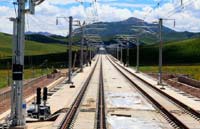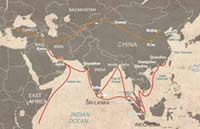 |
| Vice-premier vows to advance modern Silk Road |
|
 |
| Silk Road railway in NW China nears completion |
|
 |
| China-Eurasia Expo in Urumqi to boost ties |
Huang Shengqiang, head of the China Port Management Office, said China has already opened 25 international airports and land ports as well as 12 special trade areas along the economic belt within the country.
It will continue to build regional freight stations and create more trading platforms with Kyrgyzstan, Pakistan, Mongolia and Nepal, Huang said.
Because of the greater number of cross-border rail lines that have cut down on transport times and freight costs, more Chinese cities have discovered that these links to Central Asia and Europe can help improve regional connectivity and trade on the Silk Road economic belt.
"China will seek diversified trade methods by establishing new international procurement centers, centralized shipment control centers and transfer and import distribution centers. It will also develop a cross-border economic cooperation zone in the Xinjiang Uygur autonomous region to further promote border trade with neighboring markets," Huang said.
Since 2010, major Chinese cities, including Chengdu, Chongqing, Xi'an, Zhengzhou, Wuhan and Yiwu have began weekly or monthly train services to European and Central Asian destinations, part of China's efforts to turn its inland resources and labor-rich cities into international trade hubs.
Eighty-six cargo trains carrying 7,450 containers passed through the Alataw Pass railway station on the China-Kazakhstan border between January and July of this year, with trade volume reaching $1 billion, according to customs.
Transport Minister Yang Chuantang said regional connectivity is in the interests of all countries on the Silk Road Economic Belt. Yang added that China is following the Asian Highway Network deal signed in 2004 and the Trans-Asian Railway agreement penned in 2006 to continue its railway investment and develop major entry-exit rail and road projects.
"Countries in Central Asia and Eastern Europe, including Kazakhstan, Turkmenistan, Poland and Belarus, are eager to build new platforms for broader trade and for cultural and technological cooperation with China and other countries along the belt," said Wang Ming at the National Development and Reform Commission.
zhongnan@chinadaily.com.cn
